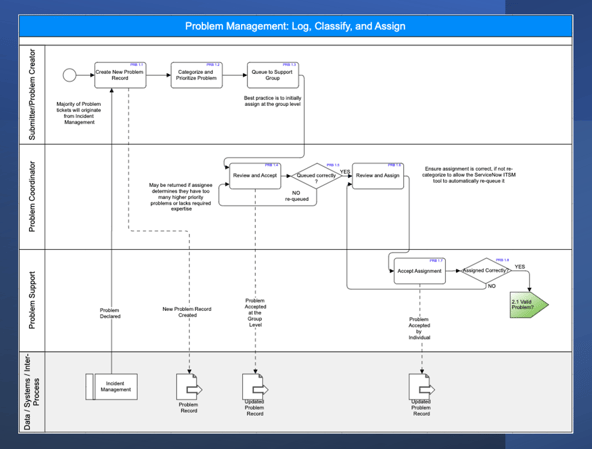Problem Management Best Practices
We're pleased to provide this comprehensive guide to Problem Management Process best practices. It's the perfect resource to help you define a new process or update an existing one!
Navvia is excited to provide the third best practice guide in our series of the five foundational ITSM processes every organization needs to have in place.
For each process, we provide a process description, key benefits, roles, responsibilities, a description of the significant activities, tips on process governance, and some design and implementation guidance.
Problem Management Description
IT Service Management (ITSM) Problem Management is a process focused on identifying, analyzing, and resolving the root causes of incidents to prevent future occurrences. Its primary goals are to minimize the impact of incidents on the business and to proactively address underlying issues.
Understanding the distinction between an Incident and a Problem is crucial for effective IT Service Management.
- Incident Definition: An Incident refers to an unplanned event that disrupts service delivery. Many incidents are addressed promptly, either through resolution or by implementing a workaround.
- Problem Definition: A Problem is defined as the underlying cause of one or more incidents, typically unknown at the outset. Problems are assigned to a designated support group tasked with investigating and determining a permanent solution or an appropriate workaround.
The Problem Management process oversees the lifecycle of all identified Problems, aiming to achieve two primary objectives:
- Prevent Recurring Incidents: Strive to eliminate the root causes of incidents to avoid their reappearance in the future.
- Efficient Resolution: If prevention isn't possible, ensure that incidents can be resolved swiftly and effectively.
Key Activities of Problem Management
The Problem Management process encompasses several critical activities and tasks:
- Log, Classify, and Assign: Record newly identified problems, categorize them based on their impact and urgency, and assign them to the appropriate support group for investigation.
- Investigate and Diagnose: Conduct a thorough analysis to identify the root cause of the problem. This phase often involves gathering data, utilizing tools for root cause analysis, and potentially developing temporary workarounds.
- Propose a Solution: After identifying the root cause, formulate a suitable permanent solution. This proposal may require input and approval from relevant stakeholders before development proceeds.
- Implement and Close: Once the solution is approved, implement it while coordinating with other processes, such as Change Management. After successful implementation, verify that the solution resolves the associated incidents and officially close the problem record.
By following these structured steps, organizations can significantly enhance their Problem Management capabilities, leading to improved service reliability and higher satisfaction among users.
Problem Management Benefits
Problem Management is a critical ITSM process that offers several benefits:
- Improved Incident Resolution: Problem Management addresses the root cause of recurring incidents. Addressing the root cause, instead of just treating symptoms, leads to a permanent solution. This reduces downtime and increases customer satisfaction.
- A Proactive Approach: Problem Management is a proactive process. It focuses on detecting trends, patterns, and common causes of incidents, so that IT teams to prevent reoccurrence.
- Cost Reduction: Problem Management drives cost savings through the reduction of recurring incidents, minimizing the need for reactive firefighting, and optimizing resource allocation.
- Continuous Improvement: Problem Management is closely aligned with the concept of continuous improvement. By analyzing incidents, identifying problems, and implementing appropriate solutions, it helps organizations learn from their experiences and enhance their IT infrastructure, processes, and services over time.
- Increased Efficiency and Productivity: Getting to the root cause of incidents frees up resources so they can focus on value-added tasks rather than firefighting repetitive incidents.
- Compliance and Risk Mitigation: Getting to the root cause of incidents, and implementing a proactive approach to problems, helps organizations stay on top of vulnerabilities, protect sensitive data, and maintain high levels of security.
- Enhanced Customer Trust and Loyalty: Builds stronger relationships with customers through consistent problem resolution and prevention, leading to increased satisfaction and loyalty.
- Better Resource Allocation: Provides insights that enable more effective prioritization and allocation of resources, ensuring critical issues receive prompt attention.
Problem management helps organizations transition from a reactive mode to a more proactive support model. The process contributes to the overall stability, reliability, and efficiency of IT services within an organization.
Problem Management and Cyber Security
Problem Management plays a vital role in enhancing cybersecurity by focusing on identifying and addressing the root causes of security incidents to prevent their recurrence.
-
Proactive Risk Mitigation
By systematically analyzing and resolving underlying issues, organizations can significantly strengthen their overall security posture. This proactive approach not only reduces the likelihood of repeated cyber incidents but also streamlines processes, improves system stability, and minimizes downtime. analyzing and resolving underlying issues. -
Valuable Insights for Defense
Through detailed documentation and analysis of past security problems and related incidents, organizations gain critical insights into potential vulnerabilities. This knowledge empowers teams to effectively strengthen defenses and prepare for future cyber threats. -
Real-World Application
For instance, if a specific type of phishing attack repeatedly compromises user accounts, Problem Management can facilitate a thorough investigation into the underlying issue, be it user training gaps, security policy insufficiencies, or technological limitations. Addressing these root causes can lead to more effective security measures, such as enhanced training programs or the implementation of enhanced content analysis and URL filtering.
Adopting robust Problem Management practices is essential for maintaining a secure and resilient IT environment. By integrating this approach into their cybersecurity strategies, organizations not only protect their assets but also build trust with stakeholders.
For more information on enhancing your cybersecurity posture, check out our post on Boosting Cyber Resilience with IT Security Assessments and ITSM Processes for more information on improving your cyber security posture.
Problem Management Roles and Responsibilities
Having clearly defined roles and responsibilities is crucial for the efficient execution of any process. This clarity helps ensure that everyone is on the same page and clearly understands their place in the process.
Process roles are not to be confused with any hierarchical status within the organization, and their responsibilities are limited to that particular process.
Here are some typical roles for the Problem Management process.
Problem Management Process Owner
A Senior Manager who is responsible for ensuring that all departments within the IT organization implement and use the process effectively.
Their specific tasks include:
- Defining the process's mission.
- Communicating process goals and objectives to all stakeholders.
- Resolving any cross-functional issues.
- Ensuring consistent execution across departments.
- Reporting on process effectiveness to senior management.
- Initiating process improvements as necessary.
Problem Manager
The Problem Manager is responsible for the day-to-day execution of the process. They take direction from the Process Owner in order to ensure consistent execution of the process across all areas of the organization.
Specific responsibilities include:
- Managing the day to day activities of the process
- Gathering and reporting on process metrics
- Tracking compliance to the process
- Escalating any issues with the process
- Acting as chairperson for process meetings.
Problem Coordinator
The Problem Coordinator is the "point person" within a support group who is accountable for all problems assigned to the group. In smaller companies this role may be performed by the Problem Manager. In larger organization these responsibilities are distributed across multiple Problem Coordinators.
Specific responsibilities include:
- Monitoring their respective queues for assigned problems
- Assessing problems and assigning to the appropriate individuals for further investigation
- Designating problems and Known Errors as "Do Not Pursue" and removes that flag if warranted
- Escalating to other groups as required
- Providing governance for all problems assigned to their own support group
Problem Support
Probelm Support refers to the people assigned the task to resolve the problem. The number of people performing this role will vary based on the size of your organization.
Problem Support responsibilities include:
- Developing an optimized workaround for the problem
- Seeking a root cause for the problem
- Developing a solution to eradicate the Problem.
Submitter / Problem Creator
This is the person who creates the problem record. Unlike incident records, which may be created by an end user, the problem record is typically created by support staff. In modern ITSM tools, the problem record can be created from within another process, with the bulk of problems being initiated from the Incident Management process.
Problem Management Activities

Here at Navvia, we strongly believe in simplifying complex processes by breaking them into high-level activities.
These activities serve as a guide, outlining the crucial steps in the process and the connections between them. We then map out the detailed tasks required to complete each activity. Organizing processes in this way makes understanding and communicating the process easier.
The following are the critical activities of the Problem Management Process.
Log, Classify and Assign a Problem
This activity is focused on recording new problems, categorizing and prioritizing them, and assigning them to the correct group and analyst for investigation. It's important to remember that problem records are typically created by IT support staff after multiple incidents with no known cause.
Investigate and Diagnose the Problem
This activity is focused primarily on two things. The first is optimizing a workaround for the incidents that can be used while the root cause is determined and a solution developed. The second is performing the root cause analysis. Once the root cause is identified, the problem can be declared a known error, with support staff relying on the workaround until a permanent fix is developed and implemented.
Propose Solution to the Problem
Having found the root cause, this activity now seeks to find a suitable permanent solution. The Problem Coordinator assigns the problem to the appropriate support group to identify and propose a solution. Remember, the permanent fix / solution is not developed in this activity, and approval should be obtained before spending time and money on developing and implementing it.
Implement the Solution and Close the Problem
This activity is focused on three things. The first is getting approval for the development of the permanent fix. There are reasons why developing a fix may not be pursued, including excessive cost or perhaps the technology being scheduled for retirement. The second is the development and testing of the fix. The third is the successful implementation of the fix. Of course, other processes, such as Change Management and Release Management, are involved in the deployment and deployment. The activity concludes with verification that the solution did resolve the Known Error. If so, the Known Error is closed, with parallel notification to Incident Management to allow that process to close all related incidents.
Key Process Relationships
Problem Management is a crucial process within IT Service Management (ITSM) that closely interacts with several other processes to enhance service delivery and incident resolution.
Its relationship with Incident Management is vital, as Problem Management relies on incident data to identify recurring issues that need deeper analysis, ultimately improving resolution and reducing repetition. Additionally, proposed solutions from Problem Management often require evaluation and approval through Change Management, ensuring that changes are implemented correctly and do not introduce new issues.
Knowledge Management supports Problem Management by documenting known errors and solutions, which are shared in a knowledge base to speed up incident resolution. Configuration Management aids in diagnosing problems by providing visibility into the IT infrastructure and the relationships between components.
Moreover, resolutions from Problem Management may lead to fixes that need careful testing and implementation through Release Management. Effective Problem Management also strengthens Service Level Management (SLM) by addressing underlying issues that can impact service commitments, thus enhancing customer satisfaction.
IT Asset Management helps by identifying recurring issues associated with specific assets, and the relationship with Information Security Management is important, as insights from Problem Management can enhance security measures and prevent future incidents. By effectively managing these interconnected processes, organizations can improve their Problem Management practices, leading to better service quality and a more resilient IT environment.
Problem Management Process Governance
Process governance is a crucial element of the Problem Management process. It establishes a framework that ensures effective management and execution of the process within an organization.
Key Governance Roles and Responsibilities
- Process Owner: The Problem Management process owner plays a critical role in governance by defining the process’s mission and communicating goals and objectives to all stakeholders. They also address cross-functional issues and initiate continuous improvements to enhance process effectiveness.
- Process Manager: The Problem Manager focuses on the daily implementation of the process, ensuring uniform execution across the organization. They are responsible for collecting and presenting process metrics, monitoring compliance, and reporting any process-related issues.
Team Collaboration and Continuous Assessment
Collaboration among the process owner, process manager, and other stakeholders is essential. Periodically assessing the process for gaps and opportunities for improvement is key. One effective method for this is conducting a formal process assessment. For more insights on enhancing your processes, check out our article on The Importance of a Process Maturity Assessment.
Benefits of Strong Process Governance
Robust process governance enables organizations to maintain consistency, drive efficiency, and foster continuous improvement in their Problem Management practices.
Problem Management Process Design and Implementation
Implementing an ITSM process is more than just deploying a tool; it involves a well-defined strategy for successful adoption. Here’s a straightforward five-step guide to help organizations implement ITSM Problem Management:
- Identify gaps: Assess your current processes and tools to uncover areas for improvement. This review should include evaluating outdated documentation, the functionality of existing ITSM tools, and integration issues between systems.
- Collaborate with stakeholders: Engage all relevant stakeholders, including IT staff and business leadership, early in the implementation process. Gathering their input ensures that diverse requirements are integrated into the Problem Management design.
- Define and document your process: Once you have identified the gaps and gathered input from stakeholders, it's time to define and document your Problem Management process. Outline activities, tasks, roles, and responsibilities, aligning with industry best practices such as ITIL, COBIT, or ISO 20000 an by following Process Documentation: A Complete Guide.
- Capture User Stories: Collect user stories and requirements to inform the design and development of the ITSM tool. This ensures that the tool meets end-users’ specific needs and expectations. Check out this webinar: User Story Mapping: A Process-Driven Approach
- Ensure Sustainability: Provide comprehensive ITSM training for users and staff, establish controls for governance, track performance with metrics, and implement ongoing monitoring and improvement strategies.
By following these five steps, organizations can successfully implement the Problem Management process and its supporting ITSM tools, establishing a foundation for sustained effectiveness and continuous improvement.
Additional Resources
Here are links to additional resources to
- Webinar: Leading a Successful ITSM Tool Implementation
- Webinar: Best Practices in Process Design and Documentation
- Blog: An Introduction to Process Mapping
- Blog: Process Documentation: A Complete Guide
- Blog: Building the Business Case for ITSM Brest Practices
Maintaining a proactive Problem Management process is essential for the smooth functioning of any organization's IT infrastructure.


